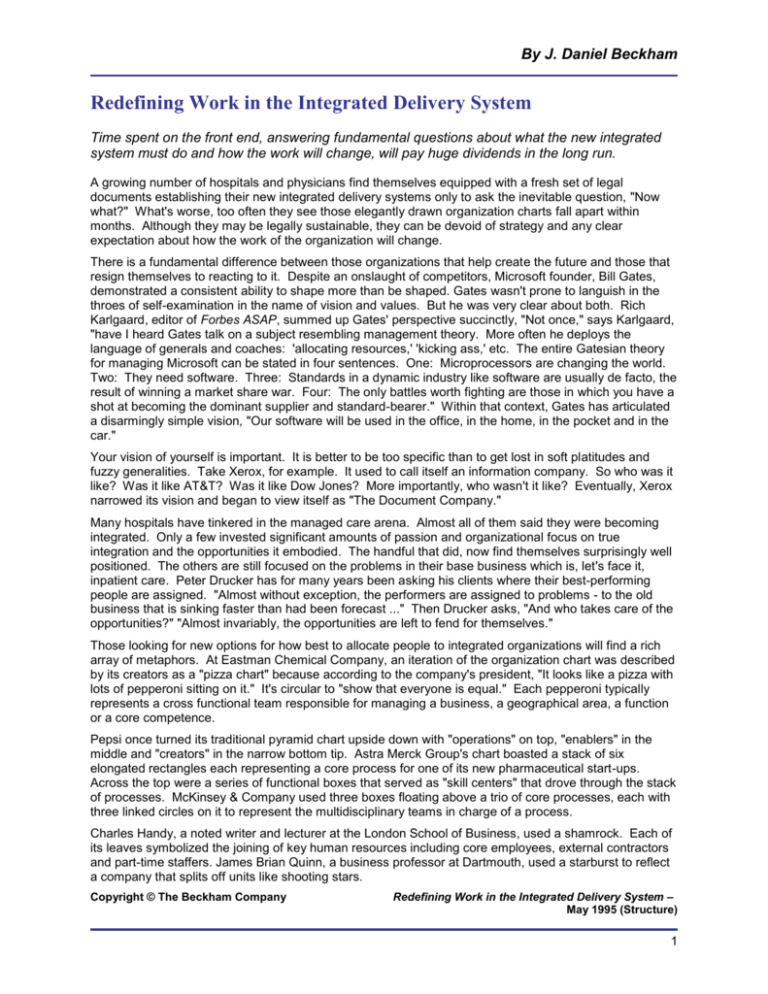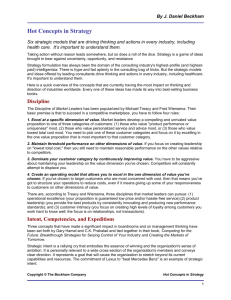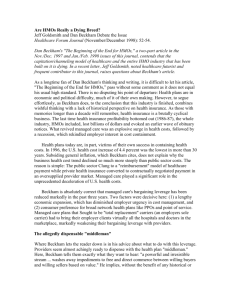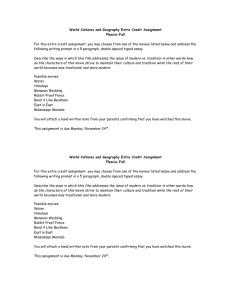Redefining Work in the Integrated Delivery System
advertisement

By J. Daniel Beckham Redefining Work in the Integrated Delivery System Time spent on the front end, answering fundamental questions about what the new integrated system must do and how the work will change, will pay huge dividends in the long run. A growing number of hospitals and physicians find themselves equipped with a fresh set of legal documents establishing their new integrated delivery systems only to ask the inevitable question, "Now what?" What's worse, too often they see those elegantly drawn organization charts fall apart within months. Although they may be legally sustainable, they can be devoid of strategy and any clear expectation about how the work of the organization will change. There is a fundamental difference between those organizations that help create the future and those that resign themselves to reacting to it. Despite an onslaught of competitors, Microsoft founder, Bill Gates, demonstrated a consistent ability to shape more than be shaped. Gates wasn't prone to languish in the throes of self-examination in the name of vision and values. But he was very clear about both. Rich Karlgaard, editor of Forbes ASAP, summed up Gates' perspective succinctly, "Not once," says Karlgaard, "have I heard Gates talk on a subject resembling management theory. More often he deploys the language of generals and coaches: 'allocating resources,' 'kicking ass,' etc. The entire Gatesian theory for managing Microsoft can be stated in four sentences. One: Microprocessors are changing the world. Two: They need software. Three: Standards in a dynamic industry like software are usually de facto, the result of winning a market share war. Four: The only battles worth fighting are those in which you have a shot at becoming the dominant supplier and standard-bearer." Within that context, Gates has articulated a disarmingly simple vision, "Our software will be used in the office, in the home, in the pocket and in the car." Your vision of yourself is important. It is better to be too specific than to get lost in soft platitudes and fuzzy generalities. Take Xerox, for example. It used to call itself an information company. So who was it like? Was it like AT&T? Was it like Dow Jones? More importantly, who wasn't it like? Eventually, Xerox narrowed its vision and began to view itself as "The Document Company." Many hospitals have tinkered in the managed care arena. Almost all of them said they were becoming integrated. Only a few invested significant amounts of passion and organizational focus on true integration and the opportunities it embodied. The handful that did, now find themselves surprisingly well positioned. The others are still focused on the problems in their base business which is, let's face it, inpatient care. Peter Drucker has for many years been asking his clients where their best-performing people are assigned. "Almost without exception, the performers are assigned to problems - to the old business that is sinking faster than had been forecast ..." Then Drucker asks, "And who takes care of the opportunities?" "Almost invariably, the opportunities are left to fend for themselves." Those looking for new options for how best to allocate people to integrated organizations will find a rich array of metaphors. At Eastman Chemical Company, an iteration of the organization chart was described by its creators as a "pizza chart" because according to the company's president, "It looks like a pizza with lots of pepperoni sitting on it." It's circular to "show that everyone is equal." Each pepperoni typically represents a cross functional team responsible for managing a business, a geographical area, a function or a core competence. Pepsi once turned its traditional pyramid chart upside down with "operations" on top, "enablers" in the middle and "creators" in the narrow bottom tip. Astra Merck Group's chart boasted a stack of six elongated rectangles each representing a core process for one of its new pharmaceutical start-ups. Across the top were a series of functional boxes that served as "skill centers" that drove through the stack of processes. McKinsey & Company used three boxes floating above a trio of core processes, each with three linked circles on it to represent the multidisciplinary teams in charge of a process. Charles Handy, a noted writer and lecturer at the London School of Business, used a shamrock. Each of its leaves symbolized the joining of key human resources including core employees, external contractors and part-time staffers. James Brian Quinn, a business professor at Dartmouth, used a starburst to reflect a company that splits off units like shooting stars. Copyright © The Beckham Company Redefining Work in the Integrated Delivery System – May 1995 (Structure) 1 By J. Daniel Beckham Of course, these charts may be more useful for conceptual doodling than organizing real work. According to an article by John Byrne (in Business Week), for more than a decade, the New York-based Conference Board has been compiling organization charts from real live companies worldwide. An examination of those charts revealed that they have grown flatter with fewer reporting levels and have become more decentralized as well. Despite this, only a few charts reveal what Byrne and others called the new horizontal organization which he describes as largely eliminating "both hierarchy and functional or departmental boundaries. In its purest state, the horizontal corporation might boast a skeleton group of senior executives at the top in such traditional support functions as finance and human resources. But virtually everyone else in the organization would work together in multidisciplinary teams that perform core processes, such as product development or sales generation. The upshot: The organization might have only three or four layers of management between the chairman and the staffers in a given process." In a horizontal structure, almost every aspect of corporate life is profoundly altered. Companies organize around process - developing new services, for example - instead of around narrow tasks, such as forecasting market demand for the service. Self-managing teams become the building blocks of the organization. Performance objectives are linked to a balanced set of indicators. And employees are rewarded not just for individual performance but for the development of skills and for team performance. Core competencies are those things that allow organizations to create value in ways not easily matched by competitors. This is the muscle of the organization. It is cut away only at the cost of diminishing the sustainability of the company. Robust integrated delivery systems are created with such competencies firmly in mind from the beginning, not as a retrospective exercise. Robert Tomasko, author of Rethinking the Corporation, identifies a two-sentence exercise that can be used to identify core competencies. "We know best how to "Our ability to (fill in the blank) (fill in the blank) ." really sets us apart from our competitors." According to Tomasko, "Activities that remain on the list after these questions are answered are the ones most worthy of organizing around." They are also the activities that deserve most to be improved and fortified. Busting up old processes takes more than incremental improvements. As reengineering guru, Michael Hammer, was fond of saying, "There's no point in paving the cow path." One way to obliterate obsolete, inefficient or redundant processes is to hit the organization with "stretch targets." Forget incremental improvements. (10% improvements in what? Building slide rules?) Demand 30%, 50% improvements in value delivered to customers. Customers don't care about whether your budgets came in five days ahead of schedule. When's the last time a customer called and said "Hey, that was a great budget. I'll tell my friends." General Electric's former CEO, Jack Welch once said, "We used to nudge the peanut along, moving from, say, 4.73 inventory turns to 4.91. Now we want big stretch results like ten turns or 15 turns." A critical aspect of the move to "stretch targets" is a willingness to turn authority over to those on the front line where the work is getting done. It should be noted that many organizations that have employed stretch goals admit that it wipes out some employees who can't handle the pace and it's often no fun. Here are four keys to making stretch targets work according to Fortune writer Shawn Tully: Set a clear, convincing long-term goal. Translate the goal into one or two specific stretch targets. Use benchmarking to prove that the goal is possible. Get out of the way. For Boeing Aircraft, its challenges included not only competition from the Airbus Industries, but competing with old aircraft still in use. There was only one way out. It had to lower prices so dramatically that it's cheaper to buy and operate new planes than repair and operate old ones. So Boeing set a stretch target of reducing the cost to manufacture a plane 25%. In 2009, Mayo Clinic announced that it intended to shave its costs by 25% to meet the unrelenting slide in Medicare reimbursement. Copyright © The Beckham Company Redefining Work in the Integrated Delivery System – May 1995 (Structure) 2 By J. Daniel Beckham Canon employed the same thinking when it determined that to compete effectively for the small office and home market for copiers it had to bring a product out at less than $1,000. To accomplish this, it fundamentally reinvented the copier. Ultimately, that is one of the most significant advantages of a stretch goal. It often requires a fundamental rethinking of how the organization, including its products and services, creates value. The barriers to the meaningful change explicit in integration are many. Culture comes with the territory, of course. Two guys who eat alone in the same lunchroom for a few days begin to cultivate a culture. On the first day they start to talk and discover they went to the same high school and both like the 49ers. And then they agree the second shift foreman is a snot-nosed kid. A culture is born. A few thoughts on culture. First, it's a natural phenomenon forged largely out of common experience. And there's nothing sacred about it. It can be good or bad. Inspired or petty. Freewheeling or authoritarian. Gracious or mean-spirited. There's a good deal of talk these days about honoring diversity. In truth, organizations can't stand too much diversity. By definition, a corporate culture, if it is to be cohesive and sustainable, must drive out some diversity. Time must be spent to define those aspects of an existing culture which are conducive to the organization's mission and vision. Those aspects should, of course, be reinforced. Irrelevant or negative aspects of a culture need not be preserved or even respected. Organizations don't exist to preserve corporate cultures. It's the other way around. Research consistently demonstrates that organizations find that the most common barriers to change are employee resistance and "dysfunctional corporate culture." A dysfunctional culture is one whose shared values and behavior are at odds with the organization's best interests. An organization might reward individual performance, for example, even though it owes its past and future success to teamwork. Tidal waves move to shore unnoticed, barely rocking boats in deeper water until their force begins to bump into the bottom. All the energy in the wave moves the only place it can - up. Then it crashes onshore. Film director and producer, George Lucas, described the work environment as being "at one of those socioecological historic pivot points that changes the way society is going to work forever. It's as dramatic a change as the Industrial Revolution was. To a lot of people, it's scary because the world is turning upside down, but for those of us who like the future, it's exciting." More than one expert has predicted the imminent "death of the job." Instead of jobs and careers, people will find themselves presented with projects and assignments. Middle management will continue to be squeezed as workers become self-managed, self-trained and self-motivated. According to William Bridges in his book, Job Shift, "...what is disappearing is not just a certain number of jobs - or jobs in certain industries, or jobs in some part of the country, or even jobs in America as a whole. What is disappearing is the very thing itself: the job. That much sought after, much maligned social entity, a job, is vanishing like a species that has outlived its evolutionary time." Here's another verb for you. According to Bridges, many organizations are well on their way to being "dejobbed." What are the traits of the dejobbed organization? Bridges suggests they: Encourage rank and file workers to make operating decisions once reserved for managers. Give people the information they need to make decisions. Give employees lots of training, particularly that which equips them with the perspective necessary to think like an owner. Give employees a share of the company profits as a reward for performance. Decades ago, Melvin Anshen suggested in an article in the Harvard Business Review, that the traditionally structured hierarchy is designed to maintain the status quo. He went on to say that the "single organization pattern that is free from this built-in bias [towards the status quo] is the project cluster." At Microsoft and Apple, many employees have often found themselves hired to a project which becomes their reason for being in the organization. Copyright © The Beckham Company Redefining Work in the Integrated Delivery System – May 1995 (Structure) 3 By J. Daniel Beckham Even if the job isn't dead in most organizations, it's certainly in the midst of radical redefinition. The editors of Business Week once declared, "the new compact between company and worker dismisses paternalism and embraces self-reliance...the new compact still binds employers and employees in a web of loyalty and mutual responsibility - a blend of community and autonomy. But it no longer protects from the reality of competition. Perform, it demands, and we shall see. Share in the risks. No guarantees." In an environment that demands improvements in quality and reductions in cost, an integration effort that fails to produce a leaner and simpler organization is not worth the effort. Paul Saffo of the Institute for the Future in Menlo Park, California, once put it simply, "The Nineties are not a good time to work in a large organization." He suggests the size of an effective organization is plummeting. In Business Week, Otis Port provides a succinct summary of what the newly redesigned organization should do with its "leanness." He provided his summary in the context of manufacturing, but it doesn't take much imagination to make the transition to health care: "Whatever its name, the new model will be a radical departure. It envisions bursting through factory walls to electronically link the plant floor - plus support functions such as design and purchasing - into a dynamically responsive environment. With this information-driven approach, success will hinge more on a company's skill at exploiting on-line resources than on its size or who owns the factory. Huge manufacturers will be as nimble as small ones. And start ups will stand toe-to-toe with behemoths by tapping computer networks for key resources. Information will whiz electronically every which way among teams - not necessarily in the same place or same company - that will collaborate on design, logistics, production, marketing, and customer service. The upshot will be a responsive factory that builds today what customers ordered yesterday for delivery tomorrow." Not only are companies becoming leaner, they are developing leaner products. Products whose design is integrated so as to minimize parts and imbed growing levels of computer technology. Boeing's 777 has only two engines, needs only two pilots and costs 25% less to operate than older models. It was the first aircraft to be designed completely on computer. Not only was the 777 a simpler product, it was a more flexible product, allowing airlines to configure a wide range of seat and lavatory setups that could be changed as needed. Hospitals got caught in a world frozen between medical craft guilds and early 1900s smokestack industry. Nothing more clearly represents this frozen condition than the state of hospital information systems. Arguably, no other business produces so much data or ought to be more reliant on it than an American hospital. Not only is the data important to financial transactions and analysis, it is fundamental to safe clinical care. Yet, no industry invested so little in information systems and none failed so completely at integrating it. Many hospitals and physicians still rely on outmoded paper records organized by visual color codes, alphabet and number. In other words, they use a system that first became common in the late 1800s. That's changing but slowly and very late in the game. In the New England Journal of Medicine, Jerome Kassirer, M.D., once envisioned a more expansive and pervasive role for information systems. He anticipated the current conspicuous trend toward industrialsize delivery networks "will be overshadowed by revolutionary changes brought on by 'on-line computer assisted communication between patients and medical data bases and between patients and physicians...' which will replace a substantial amount of the care now delivered in person." Several subtle trends revealed this potential according to Kassirer, including the rapid growth of computer-based electronic communication, a growing consumer acceptance of electronic data transfer and the shift towards greater patient responsibility for their own health care decisions. He also sees doctors expected to interpret much more information than in the past. They will find themselves suddenly accessible to online patients from great distances away. Personal encounters between doctors and patients will begin to take place only for the most serious problems. According to Kassirer, demand for physicians may diminish. In retrospect, Kassirer was overly optimistic, but the future he predicted is just around the corner. Copyright © The Beckham Company Redefining Work in the Integrated Delivery System – May 1995 (Structure) 4 By J. Daniel Beckham "Virtual organizations" may have sounded like the latest in a long litany of over hyped concepts peddled by consultants, but they're for real. Many companies now operate without significant investment in infrastructure while producing successful products. Such organizations embody acceptance of a mindset that is distinctly nomadic. A generation of entrepreneurs and managers came of age in an era that saw massive corporate edifices crack and crumble, trapping many of their inhabitants in the rubble. They dusted themselves off, and when they started new organizations they opted for the leanest structures they could assemble so they could move quickly while being unburdened by past investments and high overhead. They had no factories to refit, no real estate to unload, no seniority to honor. They could work one rich valley, strike their tents, and move to the next, carrying with them portable knowledge about customers and technologies. These virtual organizations have not only blown past old assumptions about structure and capital, they've blown past middlemen. Information is the infrastructure of new nomadic organizations. When "value added" is built around information in a computer then office space, janitors, human resource officers, and parking lots become irrelevant. So does the status associated with a corner office and a reserved parking space. Sixty-twoyear-old Jay Chiat, who converted his advertising agency, Chiat/Day, to the virtual mode in the '90s commented, "If people need a place to store their belongings and put their dog pictures, they probably won't be happy with this next evolution." Decades ago, experts predicted the future belonged to computers and robots. Many American companies invested millions in robots. They learned a hard lesson - too much automation can make you inflexible and vulnerable to change. And robots can be asked to do too much. General Motors made a multibillion dollar investment in robots in the 1980s. It installed sophisticated flexible automated systems capable of turning out a wide range of car designs. Unfortunately, GM didn't look beyond the robots to reengineer the factories they were to be part of. As a result, the robots ended up being "inflexible substitutes for labor." A more successful approach, borne of necessity, has combined computers with people and relegated robots to simple jobs like spot welding. While America excelled for decades at the manufacture of "hard products" like cars, tractors, and tools, it quietly became the 1,000-pound gorilla when it came to building software. Value became much more deeply imbedded in software than it did in hardware. Commoditized PCs proliferated in offices and spread just as pervasively onto the factory floor, giving rise to what Fortune writer Gene Bylinsky once described as "a kind of super brain hovering over the factory floor." The assembly line was a great idea in its time. Indeed, some large heart surgery programs have been described as assembly lines with surgical teams moving from room-to-room, patient-to-patient with the methodical efficiency of an unseen conveyor belt. According to Hitoshi Yamada, a consultant to Sony, "There is no future in conventional conveyor lines. They are a tool that conforms to the person with the least ability." One of the latest ideas in manufacturing, interestingly, is a very old idea - craft work. Straight assembly lines are being abandoned in favor of hybrid production which combines the old-fashioned workshops, jack-of-all-trades workers, and leading edge mass production technology. Assembly lines were once ideal for unskilled workers making identical goods in high volumes. But in today's environment, an assembly line is often too rigid a concept when flexibility is the watchword. Rather than a line, a growing number of these production workshops look, according to Michael Williams in an article in The Wall Street Journal, like "Y's, 6's and even insects. Yamada commented that in many instances the perfect factory resembled the sushi chef's setup, 'He brings the fish, prepares it and keeps the books.' In the early '90s, one of his workshops looked like a three-legged spider. A team worked at desks around the belly of the spider and had responsibility for total assembly of a cellular phone. The belly spins like a lazy susan. Components are taken from it as needed. People paced their work (rather than working at the pace of a conveyor). Because the production process is circular instead of linear, one bottleneck doesn't slow down an entire line. It used to take 70 people to make 1,000 telephones a day on the old conveyor belt system. 35 people in two of Yamada's spiders cost $32,000 to set up and took two weeks to set up could provide the same productivity. At the time, a conveyor belt line cost $3 million, two to three months to put in place and took up a lot more space." Copyright © The Beckham Company Redefining Work in the Integrated Delivery System – May 1995 (Structure) 5 By J. Daniel Beckham These alternatives to the assembly line are often generically called "cells" by the architects of the new factory. Why are the cells so efficient? On the old assembly line, as many as 15 or 16 people touched a computer during assembly; if the assembly line stopped, work was disrupted up and down the assembly line. A problem in a cell that includes three people affects only that cell. Star Wars may be too mild a description for some of the innovations that started to show up in American factories in the '90s. Caterpillar Tractor Co. started testing new tractor designs on virtual reality "proving grounds." The auto industry began building prototypes by using computer generated laser beams to sculpt them in a vat of photopolymer that solidifies when the laser touches it. New machines called hexapods looked like lunar landing craft but they began undertaking extremely complex machining tasks by attacking their task with tools that maneuvered through the air from any angle. A hexapod weighs one-tenth as much as a conventional machine tool, has its own frame to stand on and can be transported quickly in the back of a truck. These new machines required a complementary organization structure if they were going to work effectively - structures that emphasized small work units, flat bureaucracies, and teams with real decision making power. Hospitals and doctors have an assembly line mentality not unlike the one that once characterized American manufacturing. The only difference is that the patient isn't sitting on a conveyor belt or hanging from a hook. Much of what hospitals do today they do because of an unquestioned obedience to outmoded notions about how to get work done. Hospitals aren't alone, of course. Today, farmers use leading-edge tractors to plant corn in rows 40 inches apart and probably can't tell you why. The answer? That's the width necessary to accommodate a plow horse. Hospitals and physicians may at first take comfort in thinking of themselves as craft oriented. They shouldn't. By definition a craftsman is responsible for the production of an entire product. The work of health care professionals is really a manifestation of the assembly line where every worker is a specialist and no one owns a whole product or process. Most hospitals don't appreciate their lineage to manufacturing. Few hospitals would describe themselves as being in the business of manufacturing care. Yet, the way they produce care suggests they are very much creatures of the manufacturing jungle. Generally, hospitals and other health care organizations have been too quick to read "integration" and think "merger and acquisition." Rather than redesign themselves for the future, they've surrendered to lawyers, accountants, and gerrymandered organization charts. Conventional wisdom in the health care industry suggests that fully consolidated organizations will have a competitive advantage. Yet, according to studies by McKinsey & Co., over a ten-year period, only 23% of mergers end up recovering the costs incurred in the deal. The American Management Association looked at 54 big mergers in the late Eighties and found that about half of them went downhill in productivity, profits, or both. The presumption is that a consolidated organization operating under the firm hand of a single leader (or co-leaders) will respond with the unity of purpose that allows it to increase the collective performance of once independent organizations while outmaneuvering competitors. Yet, the experience of many modern organizations suggests that employees can be remarkably adept at ignoring the power vested in a hierarchical power structure. Many CEOs, even good ones, have been brought to their knees by subversive organizations. Such recalcitrance requires more than an impassioned articulation of common purpose. Too often, employees of a newly consolidated organization are hard put to make a connection between its purpose and their own self interest. A well-established hierarchy of needs remarkably similar to that originally set forth by Abraham Maslow exists in most organizations. Students of sociology will remember that at the base of Maslow's pyramid of needs were the basics like food and shelter. At the very top was self-actualization. Nobody spends much time with self-actualization until the more basic needs are met. Integrators seeking to build a unified organization would do well to remember Maslow. Real unity of purpose initially is more easily built around a common commitment to mutual self-preservation and advancement than it is around lofty notions of quality and seamless continuums of care. One of the real tests of integration ought to be an organization in which the preponderance of its participants feel that they have a stake in its success. Copyright © The Beckham Company Redefining Work in the Integrated Delivery System – May 1995 (Structure) 6 By J. Daniel Beckham Today, when organizations are consolidated, it's often likely that some downsizing will result. Few changes are as unsettling as downsizing. According to the American Management Association, throughout the '90s, at least one-third of large and midsize U.S. companies reduced their work forces. But only 34% of those companies reported any increases in productivity and only 45% reported improvement in operating profits. Meanwhile, 80% of downsized companies admitted that morale among surviving employees dropped. According to an article on downsizing by Ronald Henkoff in Fortune magazine, "The best antidote to all this fear and fecklessness isn't communication or compassion or empowerment or training or eliminating useless work - although all these steps are necessary. The most robust remedy for the downsizing blues is to devise and deliver a clear and credible plan for renewed growth." True integration is a road strewn with boulders and potholes. Some of these obstacles involve conflict. Anyone who undertakes a meaningful integration effort and encounters no conflict or opposition should question whether they are making any real progress. Avoidance of conflict is not the same as managing it. As in most things, diplomacy and sensitivity are assets of great value. But so is honesty and the ability to deliver hard news. There is simply no easy way to tell 20 cardiologists that your projections suggest the market will only support 10 of them. There are many people who will be threatened by the new dynamics of an integrated delivery system. They won't embrace it no matter how much involvement and support you give them. Those integrated delivery systems that use happiness and harmony as measures of success will fail. It is the CEO's job to make as many people as happy as possible within the realities of a demanding marketplace. But make no mistake, the marketplace has no interest in the happiness of your stakeholders. It will give you loyalty and support only for as long as you deliver differentiated value. Fundamental questions about strategy and the work of the organization must be asked and answered. Lessons can be found in companies like Microsoft, Caterpillar and Boeing. And those lessons need to be adapted in corridors, surgical suites, exam rooms and waiting areas of today's hospital and physician practices. The movement to an integrated delivery system provides a unique opportunity for radical redefinition and reconfiguration. The integrated delivery system that embraces the conventional and the marginally incremental seriously underestimates the importance of the questions. Originally published in Health Forum Journal Copyright © The Beckham Company Redefining Work in the Integrated Delivery System – May 1995 (Structure) 7








